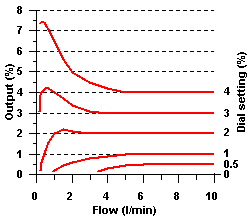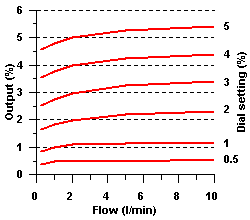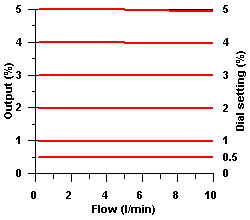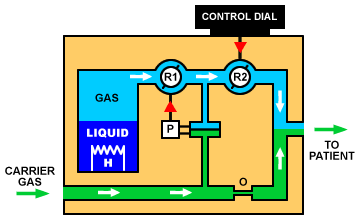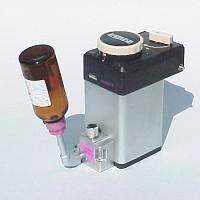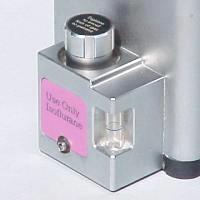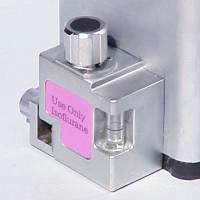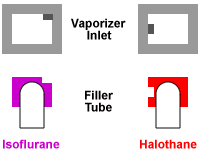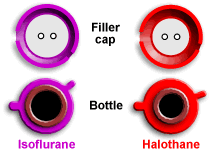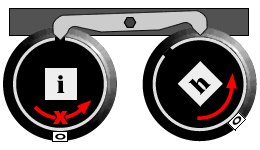|
Precision
Vaporizers
These vaporizers
include the Ohmeda 'Tec series (Fluotec, Pentec and Isotec/Fortec
for halothane, methoxyflurane and isoflurane respectively), the
Dräger Vapor 19 series, Foregger, Penlon and Ohio vaporizers.
 |
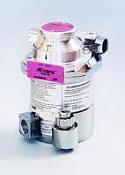 |
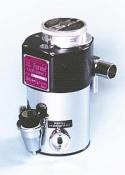 |
 |
| 'Tec
2 |
'Tec
3 |
Ohio
100 |
Dräger
19 |
Operation
The fundamental difference between the precision vaporizer and the
simple vaporizer is that the vaporizing chamber incorporates a network
of internal channels and wicks which ensures that the gas emerging
from the chamber is fully saturated with anesthetic vapor. The concentration
of the anesthetic agent in this gas is therefore known (from its
saturated vapor pressure) so, when this gas is mixed with the anesthetic-free
bypass gas, the concentration of anesthetic in the gas leaving the
vaporizer is also known. The proportion of the total gas flow passing
through the vaporizing chamber is controlled by a dial which accurately
indicates the concentration of the anesthetic delivered by the vaporizer.
Changes in
temperature
Compensation for the effects of changes in temperature on the SVP
of the anesthetic may be achieved in a number of ways:
- Minimize
temperature fluctuations by heavy copper construction which acts
as heat sink.
- Compensate
for temperature changes by a valve that varies the proportion
of the gas that flows through the vaporizing chamber.
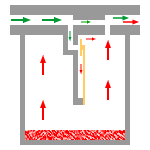 |
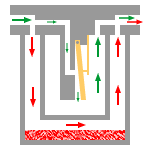 |
| Tec
2 - a bimetallic strip decreases flow through the vaporizing
chamber when temperature increases. |
Tec
3- a bimetallic strip increases flow through the bypass
chamber when temperature increases. |
 |
 |
| Ohio
100 - a bellows and thimble valve increases flow through
the bypass when temperature increases. |
Dräger
19 - an annular valve constructed of dissimilar metals increases
flow through the bypass when temperature increases. |
Gas flow
rate
Different designs of vaporizer vary in their ability to deliver
accurate concentrations of anesthetic at different fresh gas flow
rates. The following graphs demonstrate the accuracy of various
halothane vaporizers, but those designed for other agents are generally
similar in performance.
|
|
|
|
Fluotec
2
- Very inaccurate at low flows, but good for flow rates greater
than 5 l/min.
|
Fluotec
3 -
Accuracy tends to fall off at high dial setting and flow rates.
|
|
|
|
| Ohio
100 - Output increases at high flow rates and vice versa. |
Dräger
19 - Very accurate at all dial settings over a wide range
of flow rates. |
The Tec 6
Desflurane Vaporizer
The major problem
presented by desflurane is that it is extremely volatile: at 22.8oC,
its boiling point is only slightly above normal room temperature,
which precludes the use of a normal variable-bypass type vaporizer.
The Tec 6 vaporizer avoids this problem by heating the desflurane
liquid to above its boiling point in a sealed chamber and mixing
pure desflurane gas with the carrier gas.
The desflurane
liquid is heated to 39oC by a heating element (H) at
which temperature its SVP is approximately 1300 mmHg. The carrier
gas flow is restricted by an orifice (O) so that the pressure of
the carrier gas within the vaporizer is proportional to gas flow.
This pressure is sensed by a differential pressure transducer (P)
which adjusts a resistor (R1) so that the flow of desflurane out
of the vaporizing chamber is proportional to the carrier gas flow.
This enables the output concentration to be made independent of
carrier gas flow rate. The control dial adjusts a second resistor
(R2) which controls the output of desflurane gas, and thus the output
concentration.
The Tec 6 is electrically powered and electronically controlled
and so requires a mains power supply. Another complication is that,
since the vaporizing chamber is sealed from the atmopshere, a special
filler arrangement is required. Although desflurane has many desirable
properties, the very considerable expense of the vaporizer has led
to little use of this agent in veterinary practice.
Uses
Precision vaporizers can provide a highly accurate output of anesthetic
which, over a wide range, is independent of time, gas flow rate
and temperature. They are, however, heavy, expensive and require
regular servicing if their accuracy is to be maintained.
Precision
vaporizers are built for use with a specific agent and can be lethal
if the wrong agent is used (e.g. a Pentec, designed for use with
methoxyflurane, filled with halothane would deliver over 30% halothane
when full on). Their high internal resistance prevents them from
being used in the breathing circuit.
Fillers
Vaporizers
may be filled by a conventional funnel-fill mechanism, in which
the liquid anesthetic is simply poured into a funnel in the vaporizer.
The problem with this method is that, if more than one anesthetic
is used in a facility, there is nothing to prevent the vaporizer
being filled with the wrong agent. This may be prevented with the
use of a key-filler system.
|
|
|
|
Isotec
4 vaporizer with funnel-filler
|
Isotec
4 vaporizer with key-filler
|
|
|
|
|
Detail
of Isotec 4 funnel filler
|
Detail
of Isotec 4 key filler
|

In this system,
an agent-specific filler tube is used, one end of which slots into
a fitting on the vaporizer, and the other end slots into a collar
on the bottle of anesthetic. The fitting on the vaporizer and the
collar on the bottle are specific to each agent, making it impossible
(or, at least, extremely difficult) to fill the vaporizer with the
wrong agent.
|
|
|
|
Key-filler
vaporizer inlet
|
Key-filler vaporizer bottles
|
Multiple
vaporizers
It is
often desirable to mount several vaporizers in series on the same
machine so that different anesthetics may be administered when desired.
However, this arrangement presents the hazard that, if more than
one vaporizer can be switched on at a time, the patient may be exposed
to a relative overdose of anesthetic agent. In addition, the downstream
vaporizer will become contaminated with the anesthetic contained
in the upstream vaporizer. If this occurs and, for example, halothane
in the upstream vaporizer contaminates the methoxyflurane contained
in the downstream vaporizer, the methoxyflurane vaporizer will deliver
a high concentration of halothane when it was next used because
of the higher volatility of this agent.
A number of
precautions may be taken to prevent such accidents:
- A single
dismountable vaporizer may be fitted which is removed from the
machine and replaced when another agent is to be used. This has
the added advantage that only one vaporizer for an infrequently
used agent need be purchased for use on several machines. However,
there is always the possibility of a vaporizer being dropped and,
in many vaporizers, liquid anesthetic may drain into the gas outlet
and be driven into the patient circuit if the vaporizer is tipped
or inverted while it is being carried. Newer vaporizers, such
as the 'Tec 5 series and Dräger 2000, are designed to prevent
this happening.
- The vaporizers
may be arranged so that the vaporizer to be used is connected
to the circuit using flexible hose and 23 mm adapters and disconnected
when not in use. This is often the most convenient method on pole-mount
anesthesia machines.
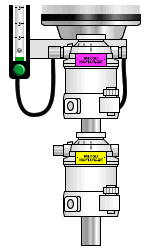
- A switch
on the back bar may be used to direct gas flow through only one
vaporizer at a time, e.g. the Fraser Harlake Selectatec back bar
and the Vapor changeover switch used with Dräger 19.1 vaporizers.
|
|
| Two
Tec 4 vaporizers mounted on a Fraser Harlake selector back bar.
The vaporizer in use is selected by the switch located between
the vaporizers on the back bar. |
- A mechanical
locking system may be used that only allows one vaporizer to be
switched on, e.g. Ohio selector manifolds and Dräger 19.3
vaporizers.
 |
| The Ohio
triple selector manifold allows the left, center or right vaporizer
to be used. Slots in the selector (arrowed) line up with flanges
on the vaporizer control dials. |
- A mechanical
inter-connector may be used to prevent more than one vaporizer
being switched on at a time, e.g. the Ohmeda Selectatec system
and Dräger 19.2 vaporizers.
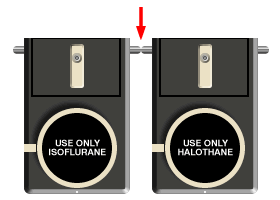 |
Ohmeda
Selectatec vaporizers incorporate pins in the manifold that
are linked to the control dial. |
 |
When
one vaporizer is in use, the pins extend and prevent other vaporizers
being switched on. |
|
|
The
Dräger Interlock 1 system for Vapor 19.2 vaporizers features
a rotating bar on the manifold with teeth that fit into a cut-out
on the back of the control dial. |
- If none
of the above is possible, mounting the vaporizer for the most
volatile agent downstream will prevent release of high concentrations
of a volatile agent owing to contamination of a vaporizer designed
for an agent with a low SVP. Vaporizers
should be arranged in the order:

This will,
of course, do nothing to prevent the patient being inadvertently
exposed to more than one anesthetic at a time.
Low-resistance
vaporizers 
|









